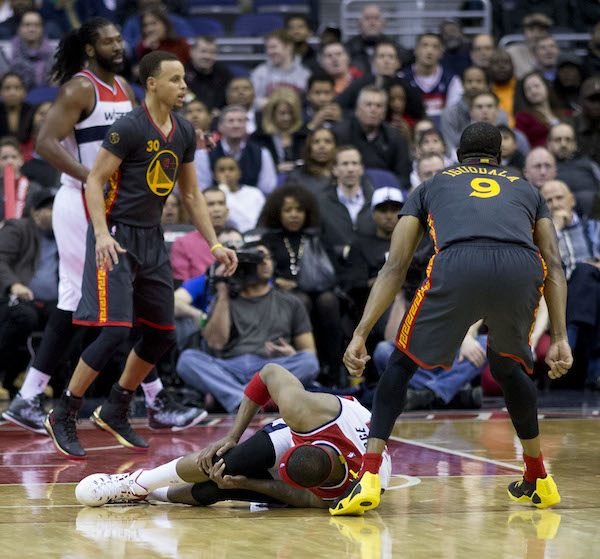Dear Sports Fan,
Why are there so many injuries in the NBA these days?
Thanks,
Adam
Dear Adam,
It does seem like every time you turn your head, another high profile basketball player goes down with an injury, doesn’t it? Just in this year’s playoffs, we’ve seen significant injuries to Kevin Love, Kyrie Irving, Kyle Korver, Chris Paul, Demarre Carroll, Dwight Howard, Paul Milsap, John Wall, and Mike Conley Jr. Just yesterday, the New York Times ran an article by Scott Cacciola entitled, As N.B.A. Playoff Injuries Pile Up, Team’s Are in Survival Mode. Before I launch into an answer, I’d like to stipulate that I don’t really know why there are more injuries. I’m not sure anyone does — at least, I can’t find anything definitive out there. There seems to be a consensus growing that the NBA would be a safer place for its players if it would shorten its regular season from 82 games to a number in the 60s or 70s. Implicit in that suggestion is the idea that what’s causing increased injury rates is the total number of minutes that players play each year. This belief is shared by coaches like San Antonio Spurs coach, Gregg Popovich, who carefully limit their best players’ playing time, even if it means holding them out of entire games.
Within every sport is long-running war between offense and defense. The battles in this metaphorical war are played out on fields and courts and rinks but they are fought not just by players but through rules, tactics, and strategies. In basketball, the war has long been slanted towards the offense but defense has slowly been pulling itself back into contention over the past twenty five years. As Bill Simmons points out in a column of his which addresses this question, the average number of points per game has fallen from 108 in 1998 to 98 in 2013. This rise in the effectiveness of defense has happened despite rule changes throughout the 1990s and 2000s that were intended to “open up the game”. How has it happened? The short answer is that a combination of technology and new analytic approaches to thinking about basketball have led coaches to invent more effective defensive tactics and demand consistent execution and effort from their players. As scoring has gotten harder, offenses have had to respond by becoming faster and more innovative on offense; using picks and other tactics to generate open shots. If you were to visualize the change the arms race between offense and defense has wrought on basketball from a bird’s eye view, you’d see that it’s made basketball faster and more chaotic with players banging into each other at higher rates and velocities. Basketball seems to have become a more dangerous sport.
If this is true, than limiting the number of minutes a basketball player plays in a given game or the number of games they play per year is very much the wrong thing to do. It may be effective in the short term — and San Antonio’s success with their minute-limiting strategy suggests that it is and has inspired many copycat teams — but it’s bad for the sport. Limiting players will only result in fewer injuries if they continue to play the way they have before, just for fewer minutes. This is not a given in the world of competitive sports, where winning is everything. For historic perspective, look at what happened to ice hockey in the 1920s and 30s as it transitioned from a game where the best players played all or a majority of the game to one where it was normal to play only a third of the game. Hockey players simply used their extra energy to go faster and harder. Nowadays hockey players rocket off their benches, play 45 seconds to a minute at a time, and hockey has become one of the most dangerous sports out there. In my series of articles on brain injuries and the NFL I argued that this same phenomenon is responsible for the danger in football. Too many substitutions and too little actual game-play has made football into a series of high intensity and high danger bursts of activity. It’s difficult to imagine how to make football safer at this point (I recommend reducing its roster size from 53 to 20) but it’s easy to see how basketball could become more dangerous in the same way. A vicious cycle that could take the sport there has already begun. Defense gets better, so offenses have to try harder and get trickier. This makes the sport more taxing and dangerous for its players. As a result, players play less. This allows them to play even harder, which makes it more dangerous, which players play less, which…
The future is a scary place but it doesn’t need to be that way. If NBA owners, coaches, players, and fans resist the urge to change too much, too fast, an equilibrium will probably naturally occur.
Thanks for reading,
Ezra Fischer

